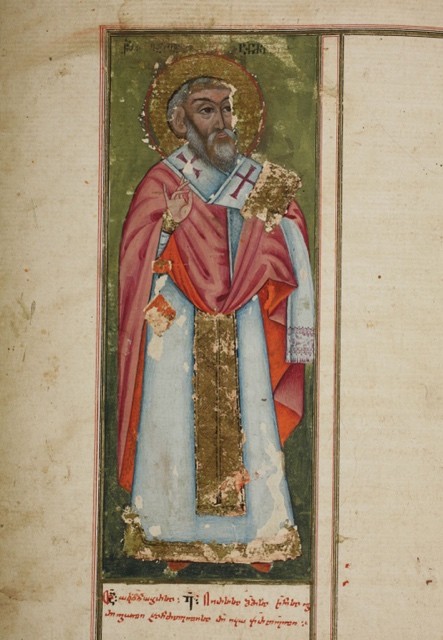Gregory of Khandzta
Miniature of Gregory of Khandzta, Collection of the 18th Century. National Centre of Manuscripts, Tbilisi.
Gregory of Khandzta (759–861) was a Georgian ecclesiastic figure and writer, organizer of the construction of the monastic complexes in Tao-Klarjeti. His life and work were described in detail by Giorgi Merchule.
Gregory of Khandzta was born into a noble family in Kartli region. He was raised at the court of Nerse of Iberia (he was the nephew and adopted son of Nerse's wife). He received an excellent education for his time. His tutors and Kartli nobles wanted to ordain him as a priest, and then, when they planned to consecrate him as a bishop (around 781), he secretly left Kartli and moved to Tao-Klarjeti. At first, he lived in Opiza, then settled in Khandzta and, with the help of secular authorities, launched a large monastery construction and recruited a large group of collaborators for this project. Gregory of Khandzta laid the foundation for monastic life in Tao-Klarjeti, he built monasteries in Khandzta, Shatberdi, Gunatle and Mere. He founded the Ubisa Monastery in Western Georgia.
Gregory of Khandzta took an active part in the political life of Klarjeti. In the 830s, he was appointed archimandrite of the Klarjeti monasteries. Through his energetic intervention, the agent of the Emir of Tbilisi, Sahak (Ishaq ibn Isma'il), – Bishop Tskiri of Ancha – was dismissed. He played a major role in the church council convened in Javakheti in the 850s, which resolved the issue of the legality of the election of Arsen I as Catholicos. With his support, Arsen I remained Catholicos.
Gregory of Khandzta's main residence, Khandzta (hence his nickname), became an important center of education. According to Giorgi Merchule, Gregory of Khandzta wrote a hymnographic collection Iadgari — a liturgical collection. He was canonized by the Georgian Church. His memorial day is on October 18. According to his own will, he was buried in the Khandzta Monastery.
Literature: იხ. სტ-თან გიორგი მერჩულე.
A. Bogveradze
L. Menabde


